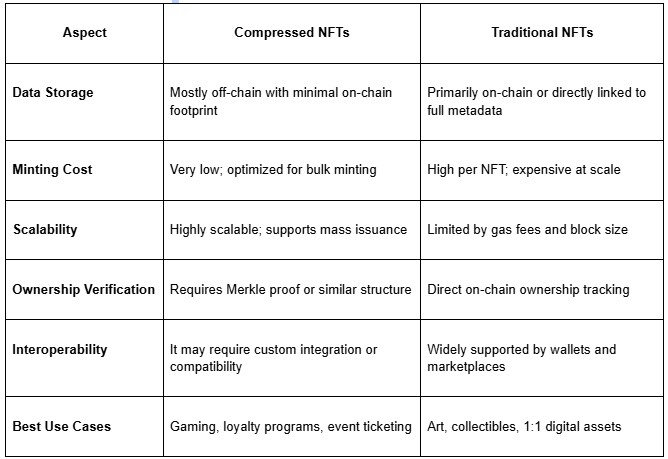Compressed NFTs are a type of non-fungible token that uses a data-efficient structure to reduce storage and transaction costs on the blockchain. Unlike traditional NFTs, which store each asset’s full metadata and state on-chain, compressed NFTs batch and compress this information to occupy significantly less space. This enables the minting of large volumes of NFTs at a fraction of the typical cost, making them especially useful for high-scale applications such as gaming, loyalty programs, collectibles, and digital ticketing.
The concept of compression in NFTs aims to solve scalability and cost limitations without sacrificing the benefits of ownership, traceability, and interoperability. These NFTs maintain their uniqueness and verifiability while offering a more affordable path to mass adoption across platforms that require millions of assets.
Compressed NFTs reduce the amount of data written directly to the blockchain, resulting in faster minting and lower fees. This process relies on alternative storage models and tree structures to efficiently track ownership.
Instead of writing every detail to the blockchain, compressed NFTs use external or off-chain data storage, such as IPFS or Arweave, to house metadata. Only essential proof or references are kept on-chain. This separation ensures that the blockchain retains a verifiable record without carrying the full weight of each NFT’s data.
By storing metadata off-chain, creators can batch thousands or even millions of NFTs without congesting the network. As long as the off-chain data remains accessible and verifiable, the NFT remains valid and functional within the ecosystem.
Many compressed NFT systems rely on Merkle trees to record and verify ownership. A Merkle tree is a cryptographic structure where individual NFTs represent leaves, and the root of the tree contains the compressed proof of the entire collection.
This enables the entire NFT collection to be managed as a single on-chain state reference. When ownership changes, only the relevant leaf’s hash must be updated and re-verified against the Merkle root, significantly reducing computation and data costs.
To validate ownership or authenticity of a compressed NFT, systems use cryptographic proofs derived from the Merkle tree. These proofs are submitted to the smart contract when needed rather than maintaining a persistent full record of each token.
This method enables scalability while retaining verifiability. As long as the tree root remains unchanged or properly updated, the compressed NFTs maintain their integrity.
Compressed NFTs offer several advantages over traditional NFTs, particularly in use cases that demand scalability and cost efficiency.
Compressed NFTs make it feasible to mint tens of thousands, or even millions, of NFTs simultaneously. This is ideal for industries such as gaming, where in-game items are issued to large user bases, or for large-scale events that distribute digital tickets or passes. The ability to mint in bulk without incurring significant fees opens the door for broader NFT adoption in mainstream applications.
Since compressed NFTs store minimal data on-chain, they significantly reduce gas or transaction fees. This is particularly beneficial on high-fee networks or during periods of network congestion. Reduced storage needs also mean that compressed NFTs have a smaller on-chain footprint, contributing to a more sustainable infrastructure for blockchain ecosystems.
By offloading data and utilizing efficient data structures, compressed NFTs enhance processing speed and minimize latency. This enables platforms to serve high-traffic users without compromising performance. This makes compressed NFTs suitable for interactive environments, such as metaverse platforms or mobile apps, where responsiveness is key.
While compressed NFTs offer significant cost and scalability advantages, they also come with certain limitations that users and developers should be aware of.
Because much of the metadata is stored off-chain, compressed NFTs depend on external systems like IPFS or Arweave for long-term data availability. If these systems become inaccessible or data is not pinned correctly, the NFT may appear broken or incomplete. This dependency creates an additional layer of risk and maintenance responsibility for creators and platforms.
Validating ownership or authenticity of a compressed NFT may require submitting Merkle proofs or interacting with additional off-chain infrastructure. This can introduce complexity for developers and may limit support in wallets or marketplaces that do not integrate such features. The learning curve and development effort may be higher compared to traditional NFT systems.
Some compressed NFT implementations may not fully conform to existing NFT standards, such as ERC-721 or ERC-1155. As a result, they might not be compatible with all platforms, tools, or smart contracts unless specifically supported. This can hinder user experience or restrict asset portability across ecosystems.
While both compressed and traditional NFTs represent ownership of unique digital assets, they differ significantly in terms of structure, cost, and scalability. The table below highlights the key differences between the two formats.

Compressed NFTs are particularly useful for high-volume, low-cost applications where scalability matters more than constant on-chain updates.
In blockchain-based games, players can frequently earn, trade, or use items. Compressed NFTs allow developers to issue large inventories of game assets, such as skins, weapons, or tokens, without incurring prohibitive costs. This ensures seamless integration with real-time gameplay and economies.
Businesses and brands can issue unique digital tokens to thousands of customers as part of loyalty programs, event passes, or promotional campaigns. Compressed NFTs make it economically feasible to distribute personalized assets at scale, with the added benefit of on-chain verifiability.
Compressed NFTs are ideal for large events that require digital ticketing for tens of thousands of attendees. Each ticket can be unique, transferable, and verifiable without bloating the blockchain or increasing fees. This approach supports fraud prevention while enabling efficient ticket management and secondary sales.